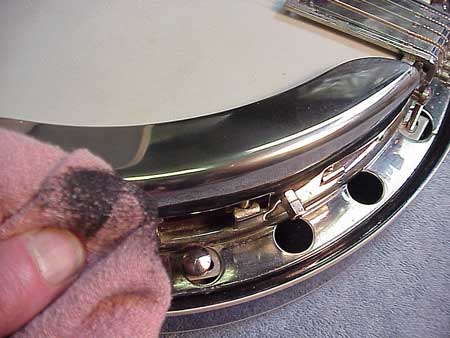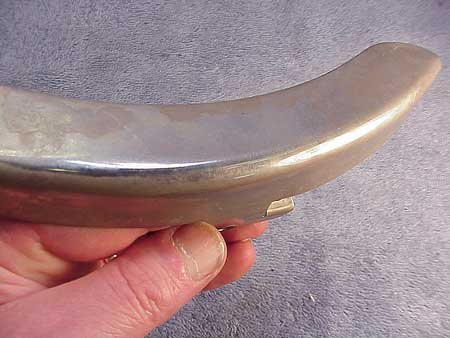Nickel Plating
© Frank Ford, 7/9/00; Photos by FF, 7/8/00
OK, I don't know if I'm ready for this, but here goes:
High quality chrome plating is more expensive but it's cheap.
Nickel plating is cheap and it tarnishes, but it's better.
Huh?
Well, I guess it makes more sense if you attack it from a historical perspective. In the 1930s and earlier, when all the great banjos were made, the standard "stainless" plating was nickel. Chrome plating existed in those days, but it was super expensive, and limited to jewelry and things like that. Car bumpers, bathroom fixtures, and all that stuff was nickel plated.
In more modern times, starting in the 1950s, chrome plating process became less expensive, so it was used on all kinds of things because of its resistance to tarnishing. Banjos got chrome plating. But, during that period, banjos were not particularly popular, with Gibson and others cutting all kinds of corners, making some pretty disreputable instruments.
As a result, chrome plating became associated with crummy banjos.
Starting with the "folk scare" of the late 1960s, banjos started an upward climb in quality, and nickel plating was reintroduced as makers looked to their past greatness.
Now, with an occasional exception, the only banjos with chrome plating are those made by factories that "just don't get it." That pretty much means Asian factories. It's not unreasonable to assume that if a factory doesn't understand that banjo players want nickel plating, they probably will also miss other things that are important to banjo players.
Here's such an instrument, a not-too-good Korean knockoff of a Gibson:

The plating is bright and shiny, just like new. In fact it's a few years old. In comparing with the nickel plated instrument below, note the general color tone of the metallic plating. Chrome has a bluish "cast."
This nickel plated banjo is about the same age as the one above, and it's starting to show the classic tarnishing:

Nickel plating has a distinct yellow cast, and some folks are motivated to call it "organic looking."
To brighten up that tarnished plating, here's my favorite metal polish:

Good old Simichrome. It's available in bicycle and motorcycle shops, auto part stores, and some hardware stores. It has the consistency of toothpaste, smells like ammonia, and won't scratch anything, including aluminum and gold.
It doesn't take much to clean up the first traces of tarnish:

But when corrosion gets heavy, nickel can be hard to polish. A full polishing requires total disassembly of a banjo, so it can be a fairly large production.
Here's one more view, this time of a recently disassembled and polished banjo. It's a nickel plated banjo, but it has a chrome plated tailpiece:

See the color difference? This is a jazz banjo with all the trimmings, a resonator tenor Bacon and Day Silver Bell Montana #1, to be exact. It's got world class tone and volume, and it's just the sort of thing that looks great in a jazz band.
As it ages, nickel starts to look like, well, an old nickel. That overall dull look is what many five string banjo players think is the best appearance for a banjo. Not too shiny, not too tarnished and pitted. It's a delicate balance, and, of course, opinions and tastes vary.
This armrest has a tarnished but fairly attractive look:

Call it "patina."
This one, on the other hand, looks like it has been etched with a powerful caustic:

It has. The player's arm. The heavy wear, uneven pitting and brass showing make this armrest mighty unattractive, and I suspect most players would agree it simply looks damaged. The cure? Replating or replacing. The prevention may have been for the player to wear long sleeves. Certainly some of us have a skin chemistry that's much more caustic than others.
This armrest has a lot of plating missing, and the brass is tarnished, too:

But somehow, it looks "vintage" rather than damaged.
Gold is gold and should be shiny, bright and elegant, but we often like the look of nickel when it starts to show its age. Interesting, isn't it?